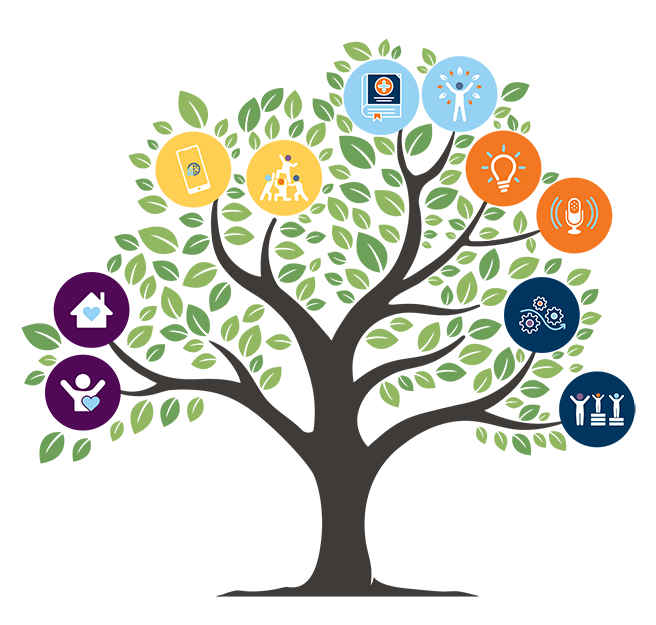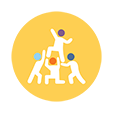Adolescent Health Gateway
The Minnesota Partnership for Adolescent Health
Safe and Secure Places to Live, Learn, and Play
Go to: Essential Themes and Priority Areas

Schools, neighborhoods, and community settings can foster and support healthy adolescent development across of the spectrum, including physical and mental health, social interactions, and cognitive growth. Young people are also spending an increasing among of time living, learning, and playing in a digital environment.
The Minnesota Partnership for Adolescent and Young Adult Health recognizes the need for young people to feel like they belong and are valued. How young people are perceived and supported in these environments plays a significant role in their feelings of connectedness and investment as part of the community. Schools, neighborhoods, and communities can foster this sense of connectedness to support healthy development across the spectrum, including physical and mental health and cognitive growth. The overuse and misuse of technology has impacted young people’s health and learning outcomes. Now is the time to provide opportunities for young people to learn about the addictive nature of devices, increase life skills, and positive habits that support healthy and balanced use of technology, and discuss digital well-being practices in the community.
Supportive Communities and Schools

Partner with schools and communities to ensure all young people are welcomed, engaged, and connected.
When young people feel connected and they feel like adults and peers in the school care about their learning, they are more likely to engage in healthy behaviors and succeed academically. Schools and communities where young people feel like they belong, and matter provider a solid foundation for young people to flourish. The goal of this priority is to strengthen and support schools and communities to create safe, engaging, and welcoming opportunities that help young people envision a promising future and are an integral part of the community. The action steps focus on viewing young people as an integral part of their community and collaborating to create environments where young people safely learn, experiment, contribute, and thrive.
Action Steps
- Support the adoption of the Whole School, Whole Community, Whole Child model
- Support positive and safe school climates and communities
- Bring a youth-centered perspective to school improvement efforts
- Connect and align youth programs across communities
- Offer guidance to young people on healthy dating and relationships and ways to identify the signs of intimate partner and dating violence
- Promote intergenerational community activities that bring together people across the lifespan
Minnesota Responses and Resources
Project Success
Project SUCCESS motivates and inspires young people to dream about the future, helps them take steps to get there, and gives them the tools they need to achieve their goals. Program activities begin in 6th grade and serve student continuously through 12th grade. Through goal-setting workshops and enrichment activities like college tours, theatre, outdoor experiences, and freshman orientation, students build life skills, supportive relationships, confidence, motivation, and graduate with plans for their future. Learn more at Project Success
- The Brooklyn Bridge Alliance for Youth
- Youth First | Northfield, Minnesota
- RiseUp Red Wing
- TheShop Brainerd – Youth Defined Space
- School Health Services - MN Dept. of Health
- Ensuring Safe and Supportive Schools
- A Toolkit for Ensuring Safe and Supportive Schools for Transgender and Gender Nonconforming Students (PDF)
National Resources
- Whole School, Whole Community, Whole Child (WSCC) | Healthy Schools | CDC
- Adolescent and School Health Fact Sheets, DASH | CDC
- Programs | YouthPower
- Healthy relationships for young adults | love is respect
Safe and Balanced Technology Use

Encourage safe, balanced, and intentional technology use while promoting digital safety and wellbeing.
Young people are spending an increasing amount of time in a digital environment to live, learn, play, and socialize with others. Nearly all young people interact daily with technology, especially social media. A 2023 Surgeon General report notes that because “adolescence is a vulnerable period of brain development, social media exposure during this period warrants additional scrutiny”. Growing up in a digital environment provides new challenges that previous generations of young people and adult youth advocates have not seen. The goal of this priority is to promote digital wellbeing and safety for young people. The action steps focus on how young people, parents and caregivers, schools, and the community can work together to make online environments safer and promote balanced technology use.
Action Steps
- Equip parents and caregivers to create a family media plan and model balanced technology use
- Promote digital wellbeing resources so that school, out of school time organizations, and other youth serving organizations can implement digital wellbeing resources for students and educators
- Provide professional development opportunities to equip educators, youth workers, and other caring adults with tools and resources to facilitate digital wellbeing discussions with young people
- Support mental and physical health care providers to have conversations with young people about safe, balanced, and intentional technology use
- Advocate for technology use questions to be included in the Minnesota Student Survey
- Engage and partner with young people in developing ideas and solutions to enhance digital wellbeing
- Promote awareness of the need for digital wellbeing through effective health communication strategies
Minnesota Responses and Resources
Live More Screen Less
The goal of Live More Screen Less is to partner with young people, families, and schools to promote balanced, intentional, and effective use of technology to promote digital wellbeing. They have a resource library with vetted, scholarly-interpreted resources to increase awareness of technology-related issues and a downloadable Toolkit to help parents and caregivers support the digital wellbeing of young people in their lives. Live More Screen less has an active Youth Council which is central to their mission. They also provide a Digital Wellbeing Certification program that equips educators and adult facilitators at community organizations and schools to have conversations with young people around digital wellbeing. Learn more at LiveMore ScreenLess
- Minnesota Attorney General's Report on Emerging Technology and its Effects on Youth Well-Being (PDF)
- Ensuring Safe and Supportive Schools
- Teens online and social media use | UMN Extension
National Resources
- Social Media and Youth Mental Health: The U.S. Surgeon General’s Report (PDF)
- American Federation of Teachers: Likes vs. Learning: The Real Cost of Social Media for Schools (PDF)
- Center of Excellence on Social Media and Youth Mental Health | American Academy of Pediatrics (AAP)
- Sexting and Relationships Lesson Plan | Common Sense Education
- American Psychological Association: Health Advisory on Social Media Use in Adolescent
- Cyberbullying Research Center - How to Identify, Prevent, and Respond